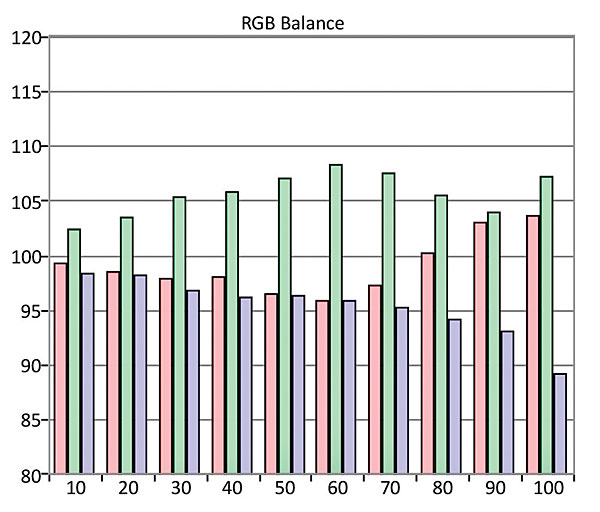The UHD65 falls short on three counts.
No 3D is a huge downfall.
Poor black levels, and so-so contrast negate the detailed picture quality that the UHD65 produces with 4k source material.
A much better option is the Epson UB5040. Its shift based technology reproduces very good faux 4k, along with excellent 3D. It has a fantastic lens and a boat full of great features.
For those who are in the market for a true 4k projector the only somewhat affordable option is the new Sony VW285ES.
Unfortunately at $5,000 is double the price of the Optoma and the Epson (both at $2,500).
Optoma UHD65 4K DLP Projector Review Test Bench
Full-On/Full-Off Contrast Ratio in HD/SDR: 913:1


Measurements were made with SpectraCal CalMAN, Photo Research PR-650, and Klein K-10A color meters anda Murideo pattern generator.For this SDR contrast, the Display mode was Reference, the Brightness control was set to –1, Contrast was at –15, Dynamic Black off, Bright mode (lamp) on Bright, Gammaon 2.4, and PureContrast turned on. The measured peak white level on my 96-inch-wide, 2.35:1, Stewart Filmscreen StudioTek 130 (gain 1.3) was 19.17 ft-L, and the black level (on a full black screen) was 0.021 ft-L. The projector’s lens zoom in this situation was roughly at its mid position. At full zoom (the largest possible image), the full-on/full-off contrast ratio measured 749:1, andat minimum zoom, 1,076:1. My room is representative of many living spaces and far from a black hole, but when totally darkened, this should not affect the readings from a full white or totally black screen.
HD/SDR
At a setting of 2.4, the gamma closely followed the BT.1886 gamma curve. Butwith PureContrast turned on—which, as discussed in the text, was absolutely critical for obtaining any semblance of respectable contrast from the projector—the gamma ranged from a low of 1.65 at 90% to a highof 2.13 at 30%.
The white balance Delta E values, from 20% to 100% pre-calibration, ranged from a lowof 2.32 at 20% to a high of 7.3 at 100%. Post calibration, with PureContrast engaged, the low value was 0.775 at 100% and the high6.9 at 50%. That may not appear to be much better, but Delta E includes not just the correct white point (D65) but also the luminance. PureContrast disrupts the gamma and the luminance, and thus it increasesthe Delta Es (as it must to accomplish its purpose). But the white balance x/y coordinates, post-calibration, were very close to their optimum values across the brightness range for D65 (x = 0.313, y = 0.329). These results are shown in the graph.
The HD/SDR color Delta Es were acceptable though unimpressive before calibration. Adjustments in the CMS improved this to values no higher than 1.7 in magenta and under 0.6 for all other colors.
(Delta E is a figure of merit indicating how close the color comes to the standard at each point in the brightness range. Values below 3—some experts allow for 4—are generally considered visually indistinguishable from ideal.)
UHD/HDR
The default gamma setting of 1.8 produced the best gamma result—that is, the UHD65’s best match to HDR’s EOTF (Electro-Optical Transfer Function, which is the specified “gamma” for UHD). The transition “knee” in the EOTF curve was a bit softer here than usual, but the x/y coordinates of the white point, after calibration, tracked the D65 white point closely above 25%. Luminance errors at the knee are common in UHD displays, which increases the white balance Delta Es. This has been typical of other UHD sets we’ve tested.

The CMS positioned the primary and secondary color points very near to their specified x/y coordinates, with the notable exception of green, which shifted slightly toward yellow. But luminance limitations did skew the color Delta Es (which, as above, include both the D65 white point and the luminance). The projector fell short of but came close to achieving the Rec. 2020 equivalents of the digital cinema P3 color points, which most home UHD sources are currently mastered to.
The peak HDR brightness onscreen varied little from approximately 100 nits regardless of how big of a peak-white window filled the screen (10%, 25%, etc. with Dynamic Black off).—TJN
- Log in or register to post comments


























































